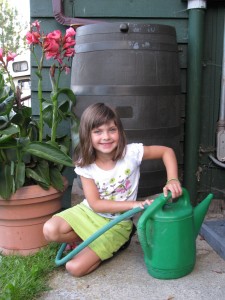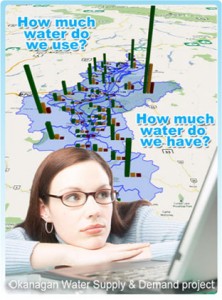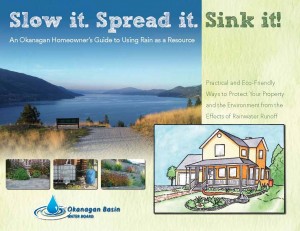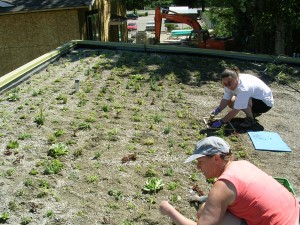“We shall neither fail nor falter; we shall not weaken or tire…give us the tools and we will finish the job.” – Winston Churchill
I once read about a farmer in Africa who’s land was bare, eroded and cracked by drought. Without many alternatives, he tried an ancient practice of piling small rows of rock along the contour of the slope. The rocks slowed overland flow from short cloudbursts, and captured dust and seeds from the wind. Within a season he could see the land begin to recover. It is a simple, effective technique now being used around the world.

Okanagan old timers talk about how most people used to have rain cisterns for drinking water. Now, rain barrels supplement irrigation water in urban back yards, and divert water that might otherwise enter the storm system.
For a while after reading this, I walked around saying “we need more stone-age solutions!” Really, it’s about appropriate technology: sometimes you need a rock, sometimes a satellite.
As information and communication become more integrated (What was life like before the internet?), distributed networks are emerging as powerful components of our social system. Rather than Big Brother gathering data and taking top-down action, responsibility is shared.
It’s happening politically (the Arab Spring, the “Occupy” movement, and the BC trend to localize planning and decision-making), and it’s happening with resource management. With less funding and capacity from the central governments, we must figure out how to protect water quality, water supplies, and the health of the ecosystem by organizing the contributions of individuals across the region.
Slow it. Spread it. Sink it! An Okanagan Homeowner’s Guide to Using Rain as a Resource is a new tool promoting distributed stormwater management. Think of it as translating the work of that African farmer to an urban environment in Western Canada. The Okanagan guide was adapted from one in Santa Cruz, California – made possible with the help of The Water Institute and Brock Dolman.
In the bad old days, the worst pollution came from point-sources: factory chimneys and outfalls, or sewage treatment plants. Cleaning these up made a radical improvement to water quality. Now, the problem is death-by-a-thousand-cuts from non-point source pollution: the accumulated nutrients, pesticides, motor oil residues and sediment washing off 100,000 lawns and driveways. Related to this, increased impervious surfaces (roofs, driveways, hardscapes) direct water off of our 100,000 yards, increasing the rate and volume of stormwater flows.
Distributing or localizing rainwater capture to individual homes and properties has huge benefits for water quality, reducing erosion, recharging aquifers, and reducing taxpayer costs of maintaining or expanding the storm sewer network. It’s good for the entire watershed.
Slow it. Spread it. Sink it! puts the basic concepts and information needed for distributed stormwater management into the hands of homeowners – who collectively have a huge ability to reduce non-point source pollution and the volume of storm flows. A limited number of hard copies will be printed: please check back at www.obwb.ca.
At their best, distributed networks can be super-efficient: in Los Angeles, an environmental group called the Tree People, have been able to save millions of dollars for the City of L.A. using distributed rainwater capture. Their founder, Andy Lipkis, now advises large urban centres across the U.S., who can no longer keep up with infrastructure costs and the increased capacity needed to keep up with climate change.
At their worst, the distributed network is taken for granted, volunteers burn out, and without a central focus, information is lost and resources are slowly degraded. Let’s just say, anarchy doesn’t work well for resource management.

The Okanagan Water Supply and Demand Project website hosts a wide array of reports and data, useful for local government planning and university research.
Other tools we’ve been developing for distributed networks are the Streamlined Water Use Reporting Tool, to better understand how much water is being extracted from Okanagan rivers, lakes, and aquifers; the Groundwater Bylaws Toolkit, to help local governments put groundwater protections in place; the Local Government Guide to the Okanagan Water Supply & Demand Project to support better urban water planning; and the Okanagan WaterWise website – an array of resources for water conservation and quality improvement.
Collaborative water governance itself is a form of distributed network, usually designed to be a hub of information and resources. Local collaborative agencies like the Okanagan Basin Water Board work best when they are connected into larger networks, and connected to a strong (though it may be lean) provincial or state government.
Related Posts: Loving the Lake so much it hurts, why we need a whole lake plan; Water Communication: making water visible.
Related Resources: The Water Balance Model: helping communities create neighbourhoods that integrate both good planning and innovative engineering designs.
Question of the day: What are your favorite tools for water management – in your homes, your agencies or organizations?




Read the story of the African farmer (Mr. Zephania Phiri Maseko) in “Rainwater Harvesting for Drylands and Beyond, Volume 1” by Brad Lancaster. Available at http://www.HarvestingRainwater.com.
And get out there and plant the rain!
Thanks for the citation Brad. I read the story in a Conservation Biology magazine, but couldn’t find the exact source. Much appreciated. There are many folks in BC interested in rainwater harvesting.
Re: “he tried an ancient practice of piling small rows of rock along the contour of the slope” from post by Ms. Sears.
I hear many people suggesting that “cluster” development is a low impact development technique. I believe that we must be careful with the definition of “cluster”. One might argue that Seattle is a “cluster development”.
I have been advocating that cluster development should mean careful (small scale) development along contour lines to mimic the “shelterwood” select logging practice. The idea is much the same as Ms Sears identifies. As far as I know, no LID manual has identified the importance of this practice.
Pingback: It’s like money in the (snow)bank | Building Bridges
We have resently moved to the Okanagan area and built a new home. I have always had concerns over water shortages and a passion to harvest it. I installed two 1500 gallon holding tanks to retain rain water that we burried in our back yard. This is used for toilets, underground irrigation, and specified hose bibs, it works great. There are local companies that supply great products for rain water harvesting. I’ve read the new public awareness information booklet on slow it, spread it, and sink, a good insite for the puplic to focus on the present and the future water shortages.
Pingback: Learning from the landscape: cultivating a sense of place in the Okanagan. | | Building BridgesBuilding Bridges
Pingback: Weddings, weird weather, and where to fit everyone - water, population growth and climate changeBuilding Bridges
Pingback: Mud-bogging and other ways we love the land too hard | | Building BridgesBuilding Bridges